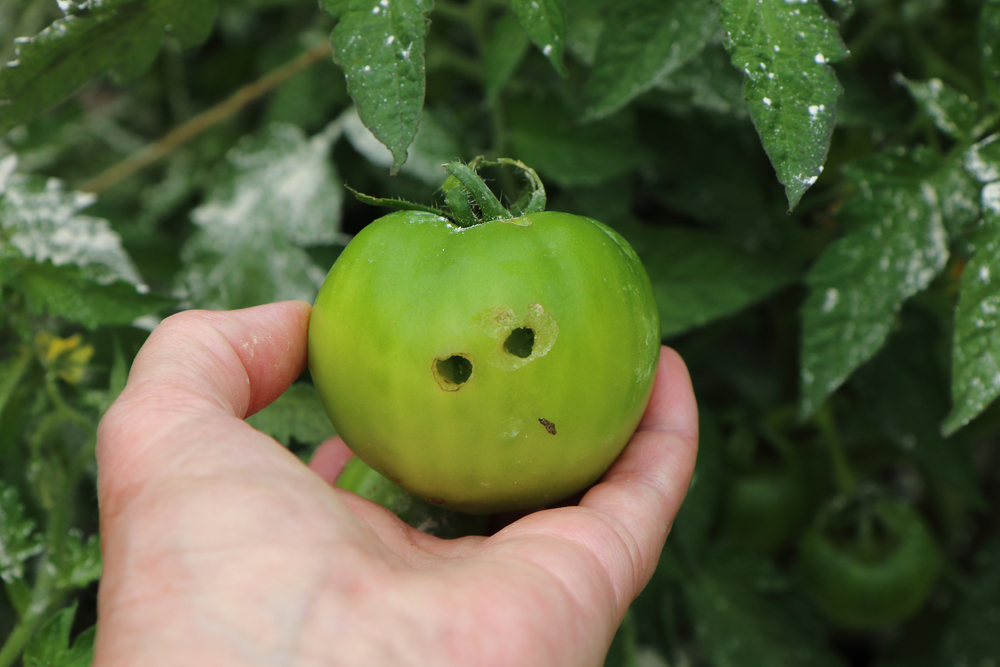
Growing tomatoes in your garden can be a hugely rewarding experience. But inevitably, as you garden, you will encounter some problems.
Often, the problems with tomato plants will be related to tomato plant diseases, or environmental problems.
But sometimes, pests will be the problem.
There are a range of common pests that prey on tomato plants. In this article, we’ll help you discover what is eating your tomatoes.
We’ll cover 20 common insect pests and how to deal with them.
Of course, which of these you are likely to encounter will depend on where you live, and the climate and conditions to be found there.
But looking through this list should help you to identify the culprits and deal with them in an organic, safe and ethical way.
General Tips for Organic Pest Control
Before we go on to look at twenty common tomato plant pests, it may be helpful to take a quick look at general pest management techniques in an organic garden.
When it comes to dealing with pests organically, prevention of an imbalance in the ecosystem is generally better than trying to find a way to deal with a sudden infestation.
Here are some ways to help reduce the incidence of a bad pest infestation:
Introduce as Much Biodiversity as Possible
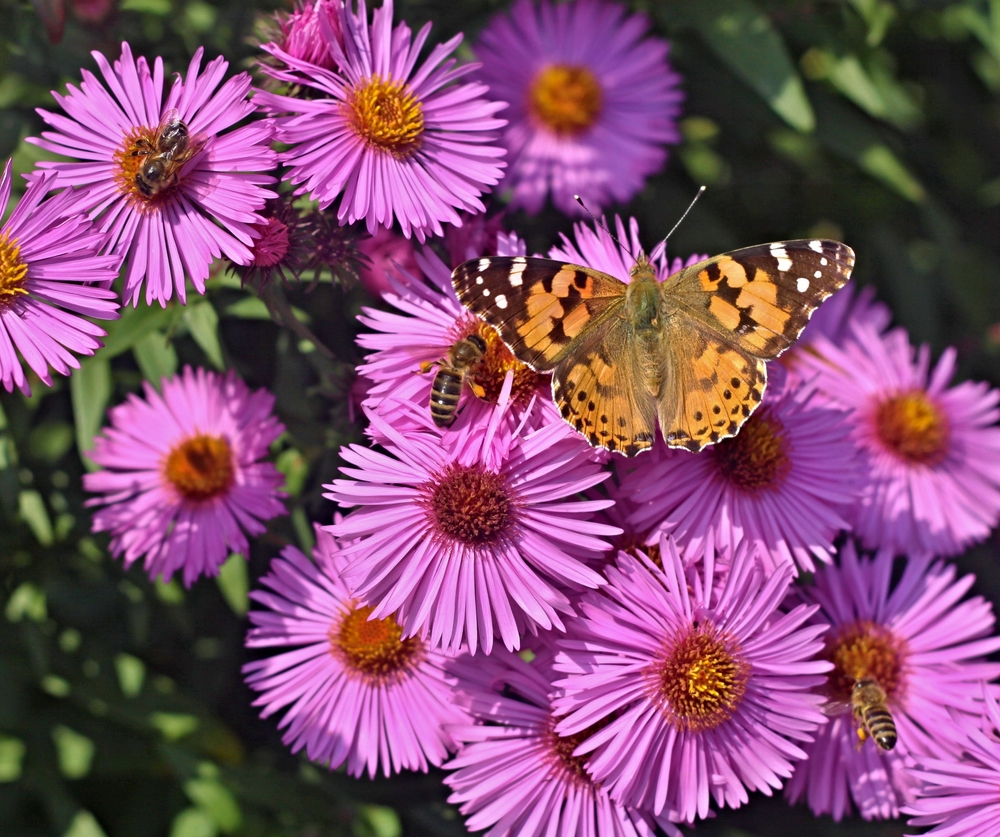
The more plants and animals there are in a garden ecosystem, the more resilient it can be.
Every ecosystem works holistically – no elements work in isolation. Both on a macro and micro scale, the more you delve into the natural world, the clearer its interconnectedness becomes.
The interconnected nature of a garden ecosystem means that things can easily get out of balance if there is not a good mix of plants and animals.
Making sure, as a gardener, that you do all you can to protect and enhance biodiversity will make your life easier.
You should plant as many different plants as possible, and draw in wildlife in whatever ways you can.
The more biodiversity you introduce, the more beneficial interactions you will generate. The different plants and animals in a system can help each other in a wide range of different ways.
Many of these ways revolve around pest control.
Well-connected and supported plants will generally be healthier and less likely to succumb to problems with pests (or disease).
Tomato plants can be surrounded by companion plants for tomatoes, which can repel, distract or confuse certain pest species.
Other companion plants may also help reduce pest problems by generally improving the environmental conditions and the health of your crops.
In an organic garden or on an organic farm, it is a good idea to avoid planting mono-cultures. Instead, you should create polyculture planting schemes and guilds, which can support your crops.
Adopting this approach can reduce the frequency of pest infestations, and reduce their severity when they do occur.
Encourage and Protect Predatory Species
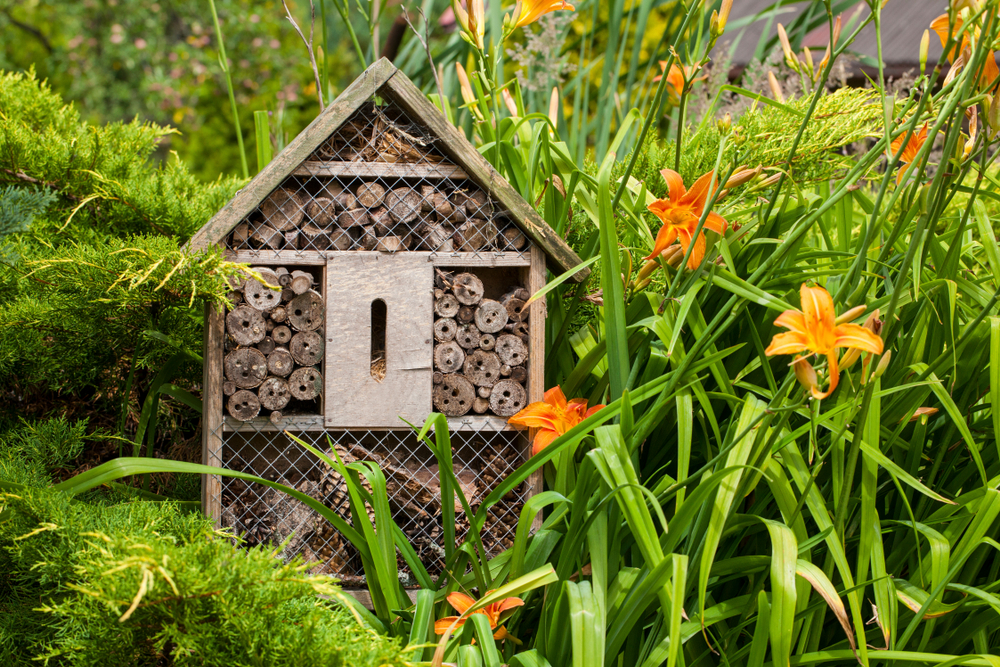
Also central to the idea of polyculture creation is attracting beneficial wildlife through planting. The right companion plants can attract pollinators and improve the yields of your crops.
When it comes to pest control, companion plants can also entice predatory insects, and other wildlife.
They will eat the pests that prey on your tomatoes and other plants.
Planting to attract predatory species is very important. But you might also encourage and protect predatory species in your garden in other ways.
For example, you might create a range of habitats to encourage such species to set up home on your property. You might make a wildlife pond to encourage, among other things, the amphibians that prey on slugs.
You might create brush piles and bug hotels.
Other ideas include providing shelter and food for garden birds, which also eat a range of common pests.
Choose the Right Plants for the Right Places
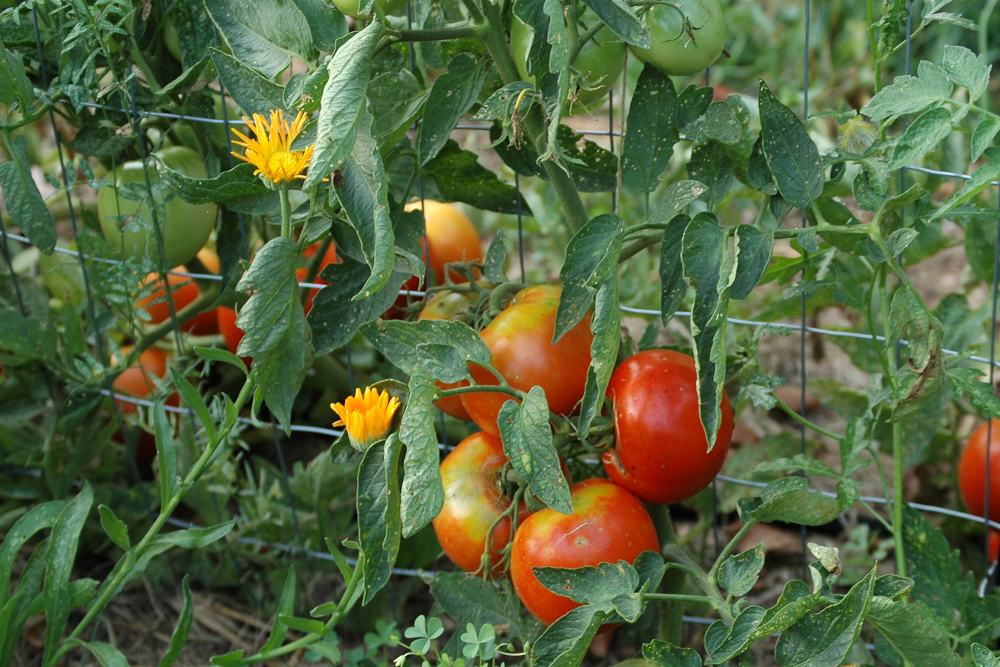
Pests (and diseases) are more likely to trouble your tomatoes and other plants when the plants are under stress.
When growing tomatoes, as when growing any other plants, it is important to grow them in the right places. You must make sure that the appropriate environmental conditions are met.
When you choose the right plants for your climate, soil and particular site, and position your plants in the right places, they are far more likely to thrive.
Pests are far less likely to take hold, and when they do, they will be less problematic and easier to deal with effectively.
Plants in excellent health are far more resilient, and more likely to be able to shrug off pest problems.
Practice Good Environmental Management
In nature, ecosystems can be amazingly resilient. Often, imbalances will be naturally addressed within the system.
In a garden, of course, we can work with nature for easier gardening and better results. But we still want to shape the natural world and manipulate it so it can meet our own needs.
What this means, in practice, is that we often have to engineer the environment. We manage the environment in order to increase yield and ensure the good health of the plants we wish to grow.
We might manage the environment in a range of different ways.
For example, we might shape growing areas to suit our needs. We might create raised beds or integrate other land-management techniques.
Another way we might manage the environment is to manipulate the flow of water across a site. For example, we will often irrigate, or water by hand.
We might introduce cover, shelter or shade, or cut back foliage to allow more light to reach our crops.
Whatever we do to manage our land, we should take care to make sure our plants always remain happy and healthy.
Again, it is important to remember that healthy plants are far less likely to succumb to pest infestations.
Provide the right light levels, water consistently and well, etc..
Practice Good Plant & Tool Hygiene
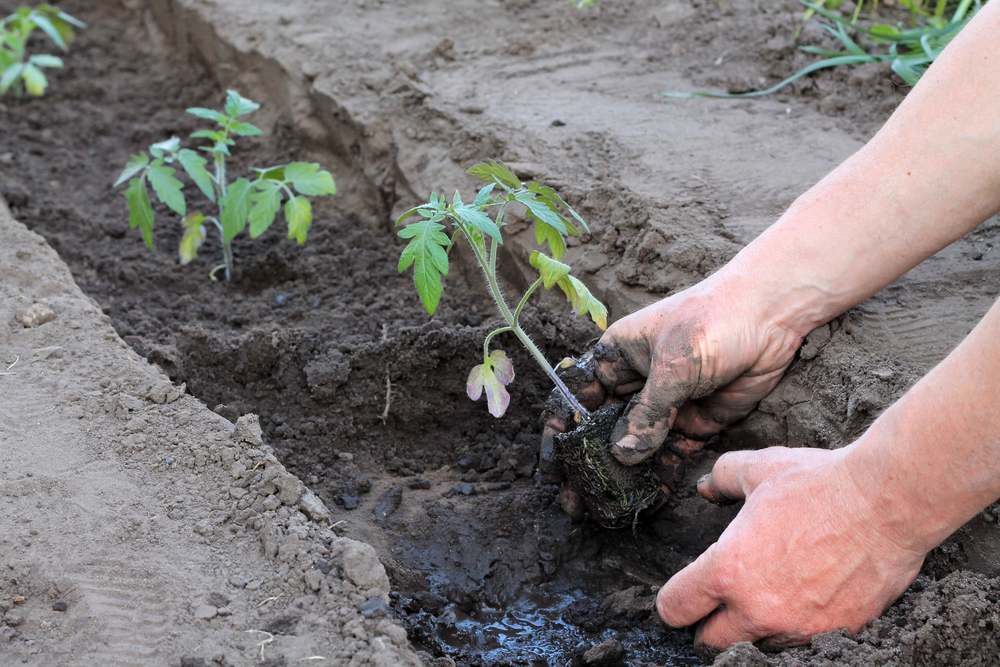
One final (and very important) thing to remember is that in an organic garden, care must be taken to avoid and prevent the spread of pests (and disease).
First of all, we should take care not to introduce any plants to our gardens that might already be infested.
When buying plants or transplanting plants from another garden, we should always check carefully to make sure we are not also introducing pests to our sites.
Cleaning all tools, containers and equipments thoroughly before and after use can also help to prevent the spread of pest species to new areas of food production.
And we can also ensure that we do not spread pests by composting contaminated matter, by leaving dead, damaged or diseased plant matter in place, or by leaving pest contaminated plant matter on the soil surface.
Of course, following these general tips will not allow you to avoid pest infestations altogether. But they should make them less frequent.
They should also make it easier to manage them when they do occur.
20 Common Tomato Pests
As mentioned above, the pests you encounter will depend on where in the world you live, and the climate and conditions to be found there.
But these 20 common pests might be what is eating your tomatoes.
If you already have an idea of the culprit, scroll down through this alphabetical list to discover how to deal with it. If you are not sure which pest you are looking at, browsing this list should give you a better idea.
Read on for details of common pests and what you might see if you are dealing with them.
We’ll also give you some tips to help you deal with each problem (or prevent a serious infestation in future).
1. Aphids
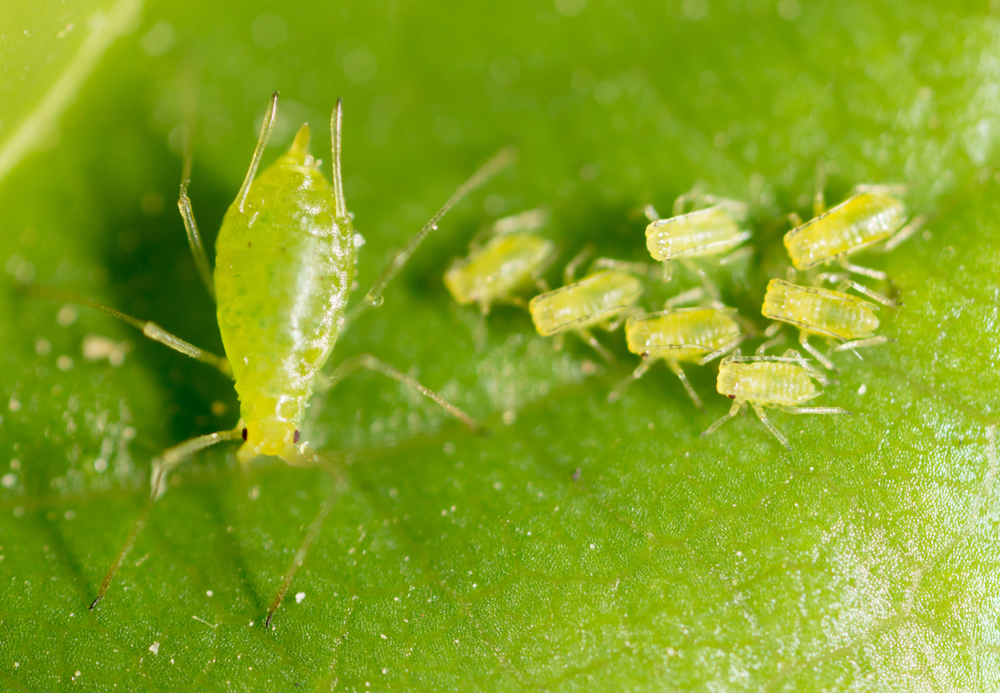
Aphids are sap-sucking insects that can become a problem not just for tomatoes but also for a range of other common garden plants and crops.
These are amongst the most destructive insect pests on cultivated plants in temperate climate zones.
You will be able to see the small, soft bodies insects crawling on the stems and foliage of your tomato plants, often close to the growing tip.
Green flies and blackflies are the common names for common types of aphid.
Fortunately, while they can cause plants to reduce in vigor and yield, a smaller infestation will not generally be too much of a concern.
Usually, you will be able to rub off the small insects by hand if there are only a few of them.
If there are more aphids than can easily be removed by hand, you could also:
- Pinch or prune off heavily affected leaves or other parts of plants.
- Use a strong jet of water to blast aphids off plants. (Spray affected plants every day until infestation is gone.)
- Create a tomato leaf spray to kill aphids without hurting beneficial insects. Take 1-2 cups of tomato leaves and steep in 2 cups of water over night. Strain leaves from the water and spray onto plants. Make sure to get the underside of leaves and be thorough.
- Consider using a solution with Castile soap (natural, liquid soap) to suffocate them.
To prevent severe aphid populations on your tomatoes in future you can:
- Plant to attract ladybugs, syrphidae species and other predatory insects eat aphids and keep numbers down.
- Plant trap crops that aphids will be drawn to in preference to feasting on your edible crops.
- Attract insect eating birds (like swifts) to your garden.
The methods described above can also work for a range of other insect pests.
2. Blister Beetles
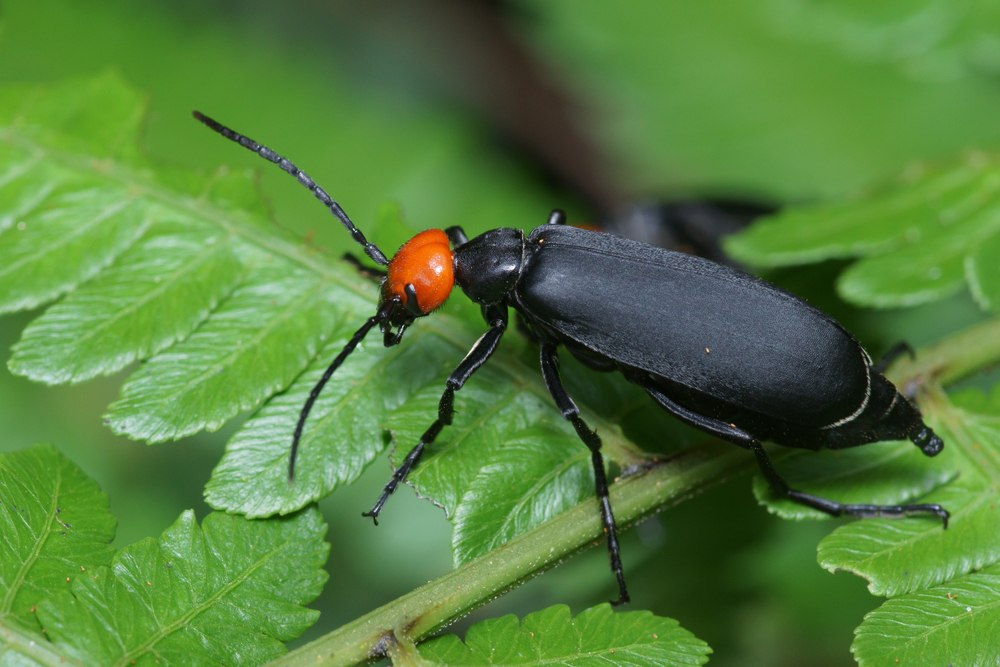
Blister beetles are members of the Meloidae family, and many different kinds are found across the US.
They are common in the east, south and midwest, though they are also found in the grasslands of the west and south, and in gardens along the Pacific coast.
These pests are best known for the harm they can cause to humans. When injured or crushed, they release a blistering agent called cantharidin.
These pests can also pose a threat to your tomatoes – and in fact to many garden plants.
In mid and late summer, they can arrive in swarms and because of their numbers, can do a lot of damage to your tomatoes in a short length of time.
Carefully inspect your plants and pick them off (with gloves!) while there are only a few of them.
If a large infestation arrives, try to remove beetles and the plants they’ve damaged as quickly as possible. If large swarms are a problem, use well-anchored row covers to protect your plants.
To keep numbers down in general, attract birds to eat them. Spinosad is a biopesticide that can be applied.
But note, this can harm honey bees when first applied, so may not be an ideal solution.
3. Colorado Potato Beetle
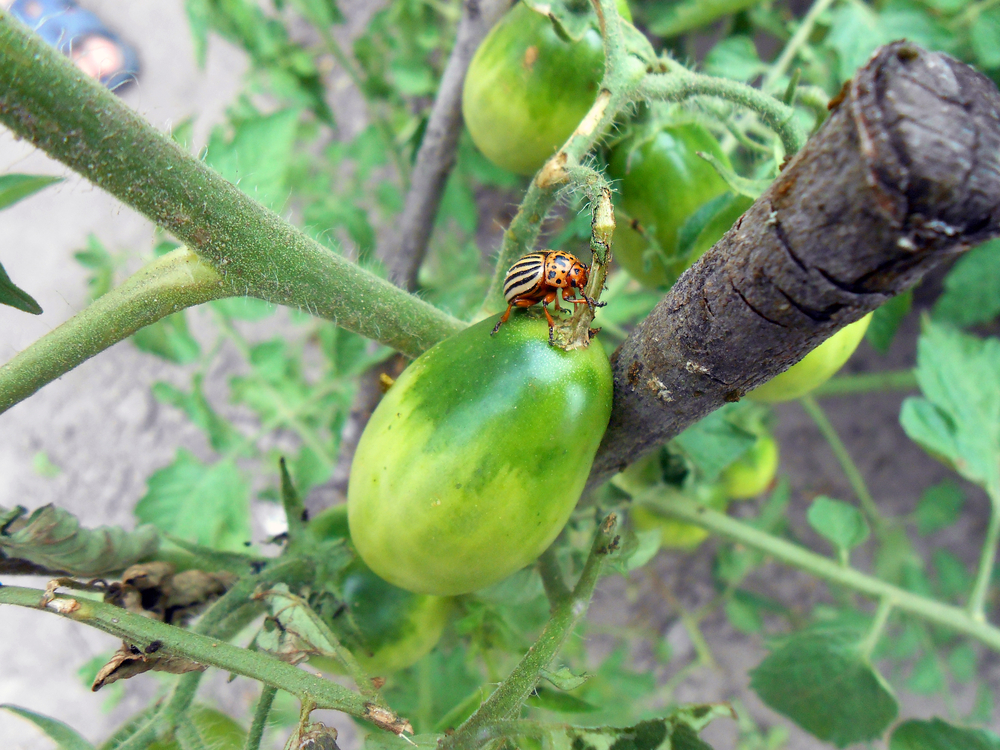
Colorado potato beetle is one of the best known and wide spread tomato pests in North America. They are found in every state except California, Nevada, Alaska and Hawaii.
This pest can affect not only potatoes and tomatoes but also other crops within the Nightshade family, such as peppers, eggplant etc..
They are easily identified by the 10 alternating yellow and black stripes on their shells.
The larvae are usually the most damaging form, feeding on the leaves leaving just the veins and petioles behind. However, the adults also feed on tomato foliage.
Severe damage can result in serious stunting of your tomato plants.
Handpicking the pests off your plants can often save them. Tomatoes can lose up to 30% of their leaves and stems without loss of yield.
Be sure to wear gloves when picking the larvae, and adults off your plants.
These pests can overwinter in the soil, so do not grow tomatoes or other members of the same family in the same spot where you grew them the previous year.
Potatoes around the edge of your garden can act as a trap crop and save your tomatoes.
Planting non-host plants like corn in the area may confuse the beetles and delay infestation. Plant to attract predatory insects like ladybugs and lacewings.
4. Cutworm
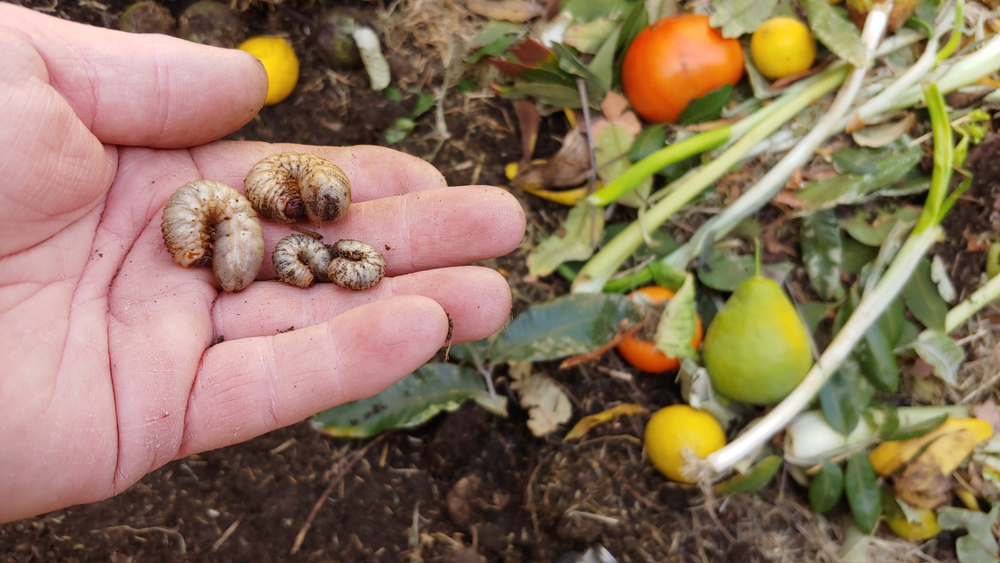
Cutworms are moth caterpillars that live in the soil.
They can belong to a range of different species. Cutworms can be particularly problematic for young tomato seedlings.
Chewing through their thin stems, they can kill a whole crop of newly planted seedlings overnight.
But cutworms can cause damage to mature tomato plants too. They can chew on stems and foliage and leave behind holes and weakened plants.
To stop cutworms from destroying your seedlings, you can place a cardboard collar (made from a 3 x10 inch strip of card) around the plant stem to create a barrier between the stem and the soil.
Cutworms will usually not climb over such a collar to reach the stems.
You can also spread cornmeal around the plants, which will kill cutworms when they eat it. You can also go out with a flashlight at night and hand-pick the culprits off your plants.
Clear away all dead plant material overwinter – cutworms overwinter in dead plant material, so good hygiene practices can help reduce recurrence.
Water well too, as this can also help to disrupt these pests.
Also, be sure to encourage predatory beetles, birds, hedgehogs or other garden wildlife that preys on these caterpillars.
5. Flea Beetles
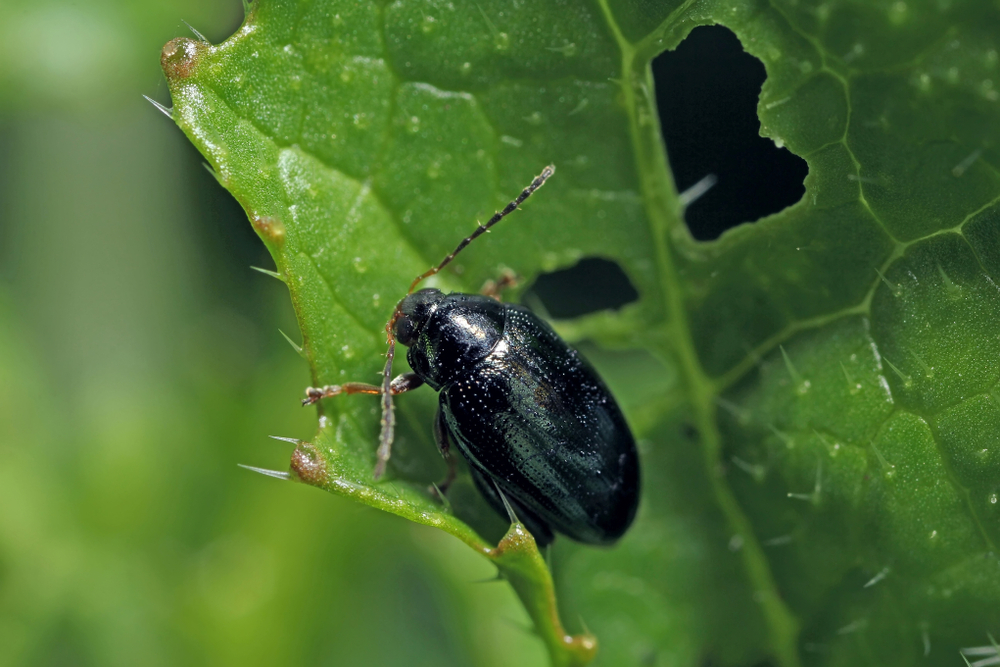
Flea beetles rarely destroy a tomato crop. But they can damage the plants and reduce vigor. Flea beetle larvae feed on underground parts of the plant, though the damage is not usually that significant.
The main problem is the adult beetles chewing on leaves.
You will see small holes that create a sieve-like appearance. Sometimes flea beetles may also feed on mature fruits. But this is rare.
Flea beetles may not kill your plants – but they can spread disease so it is important to control the problem. You can use sticky traps to catch flea beetles as they jump.
Crop rotation is key to avoiding problems, as infestations may overwinter in the soil.
Repel these pests with basil or catnip. Or use trap crops of nasturtiums or radishes.
Plant to attract beneficial predatory insects which will help keep the numbers of flea beetles down.
6. Hornworm
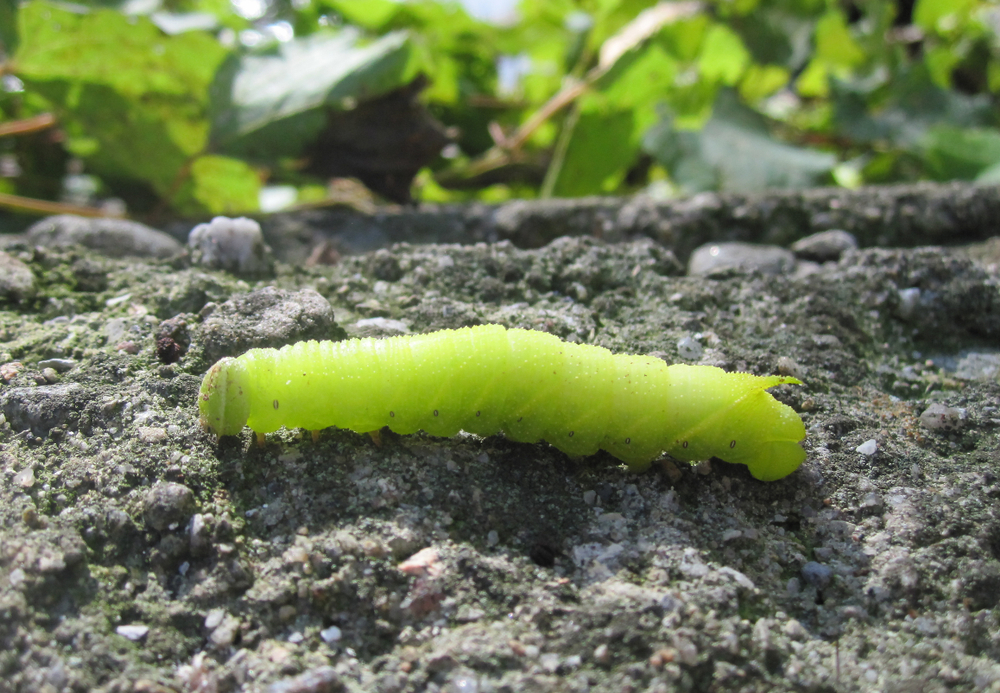
Tomato hornworm is the caterpillar of the Manduca quinquemaculata, the five-spotted hawkmoth. It is commonly found across North America and Australia.
They are especially common in the northern United States. A related species, tobacco hornworm, is more common in the south of the US and can also be a pest of tomato plants.
These large caterpillars will eat non stop and can quickly defoliate large parts of tomato plants, creating spotted and chewed leaves, and sometimes also eating the fruit.
They are camouflaged against the leaves and can be difficult to spot. Be sure to look out for dark green or black droppings on top of leaves, and lift leaves to find these large caterpillars underneath.
Being vigilant and picking them off by hand is usually the best course of action.
Encourage predatory species such as parasitic wasps, and companion plant with dill, basil or marigolds, all of which mayhelp to repel these pests.
7. Leaf Hoppers
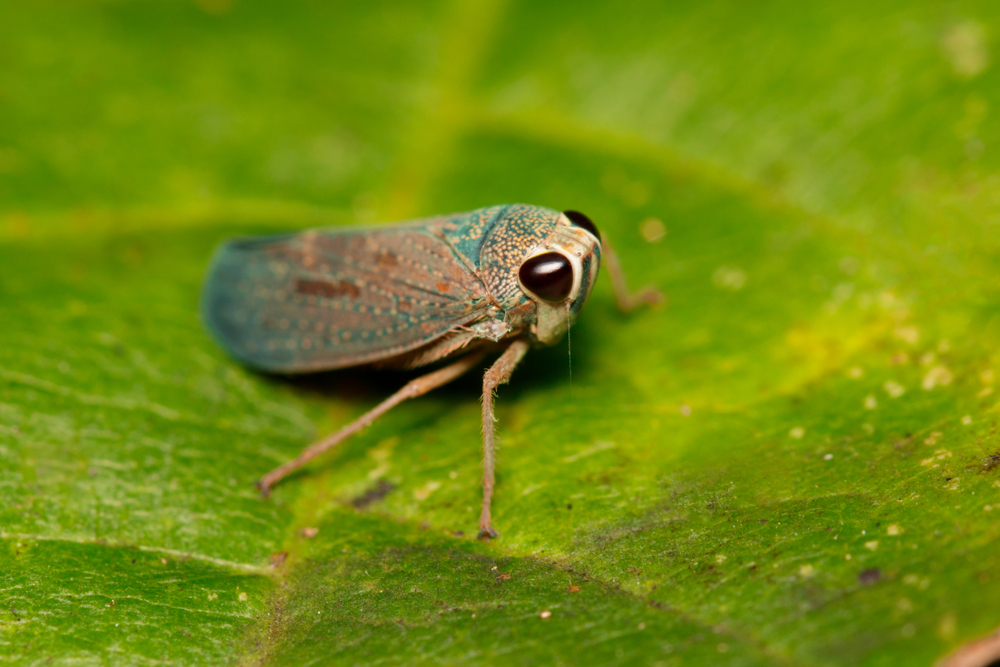
Leaf hoppers may not be the number one tomato pest. They can often cause more of an issue for other common crops.
But these sap suckers can cause yellowing, spotting, leaf curling and other problems, and can spread disease.
There are a number of different leaf hopper species across North America, and certain leaf hoppers are also found in greenhouses in the UK and elsewhere.
Leaf hoppers in glasshouses/ greenhouses in the UK can cause discoloration that can be mistaken for mineral deficiencies.
In parts of the US, beet leaf hopper is one example of a leaf hopper that can spread pathogens and become a problem on tomato crops.
Attract ladybugs, and other insect predators to keep their numbers down.
And avoid planting host species for the leaf hoppers you have encountered close to your tomatoes. Try to maintain balance in the ecosystem and only use organic pesticides as a last resort for extreme insect infestations.
8. Leaf Miners
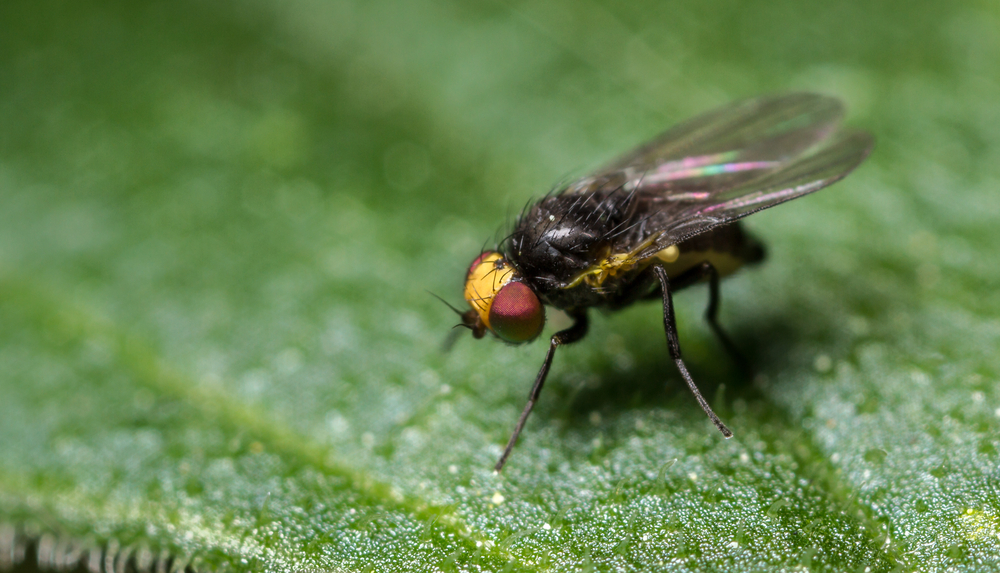
Leaf miners are a tomato pest found throughout the UK and Europe. They are a notifiable pest in Northern Ireland.
The leaf miner is a small dark-coloured fly with a yellow dot on its back.
It lays eggs which hatch into small larvae that burrow beneath the leaf surface leaving whitish-silvery trails.
A few leaf-mining flies are also common pests of tomato plants in the US, including Liriomyza sativae, L. trifolii and L. huidobrensis. These also leave similar trails and can reduce vigor of plants.
Leaves with these tell-tale tunnel markings should be removed and destroyed as soon as possible.
Pupae found on leaves should also be removed and carefully destroyed. This is usually only a problem on crops grown undercover.
The introduction of parasitic wasps is one potential form of control for serious infestations.
9. Nematodes
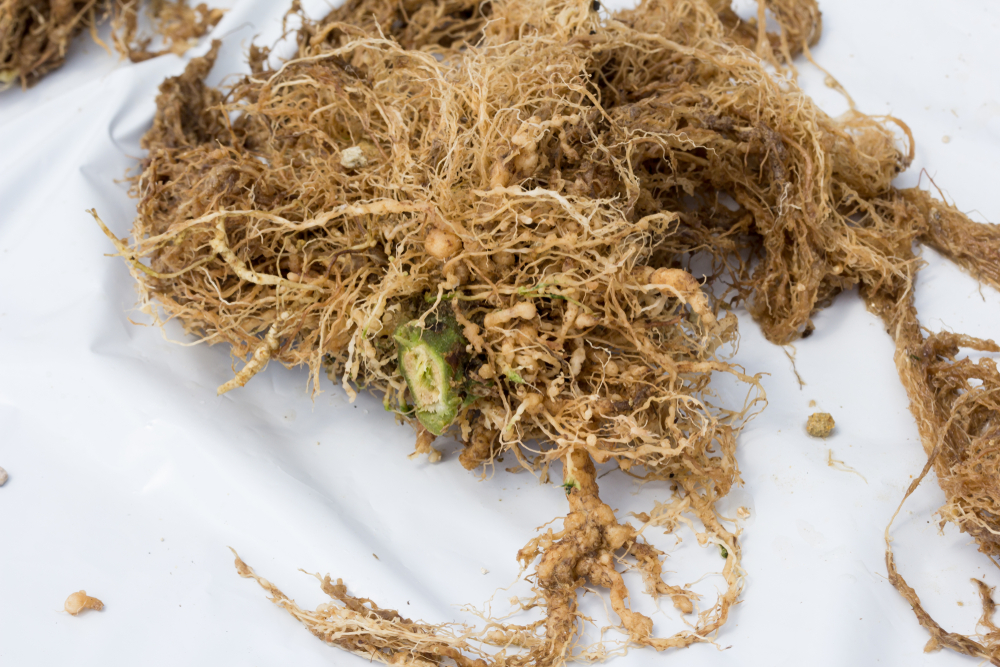
If your tomatoes are not growing well, yellowing and lacking vigor, and you pull up a plant to find it has lots of unusual knobbly growths, then it may be infected by root knot nematodes.
These nematodes, also sometimes called tomato eelworms, can be quite a serious problem. These nematodes feed off nutrients pumped through tomato plant roots, and can cause problems by impacting the plants’ ability to deliver nutrients to its foliage, flowers and fruits.
Planting marigolds can help to control certain nematodes in your garden.
If you have a severe nematode problem, you should avoid growing susceptible plants in the area for several years.
Always implement good crop rotation practices to avoid build up of the problem. Adding more organic matter can also help.
But if you have a severe problem with nematodes, growing resistant varietals may improve your chances of obtaining good harvests.
10. Pysillids
The tomato psyllid (Bactericerca cockerelli) is a small, sap-sucking insect that can damage tomato plants. It comes from South and Central America but is also found in parts of the US, New Zealand and other areas.
These insects are around the size of aphids and look like tiny cicada.
The small size of tomato psyllids makes them difficult to see on tomato plants. Moderate to severe crop damage can occur if an infestation is not treated in time.
Sticky traps can be placed, and you can look out for the pysillid sugar, excreted by these insects, on leaves.
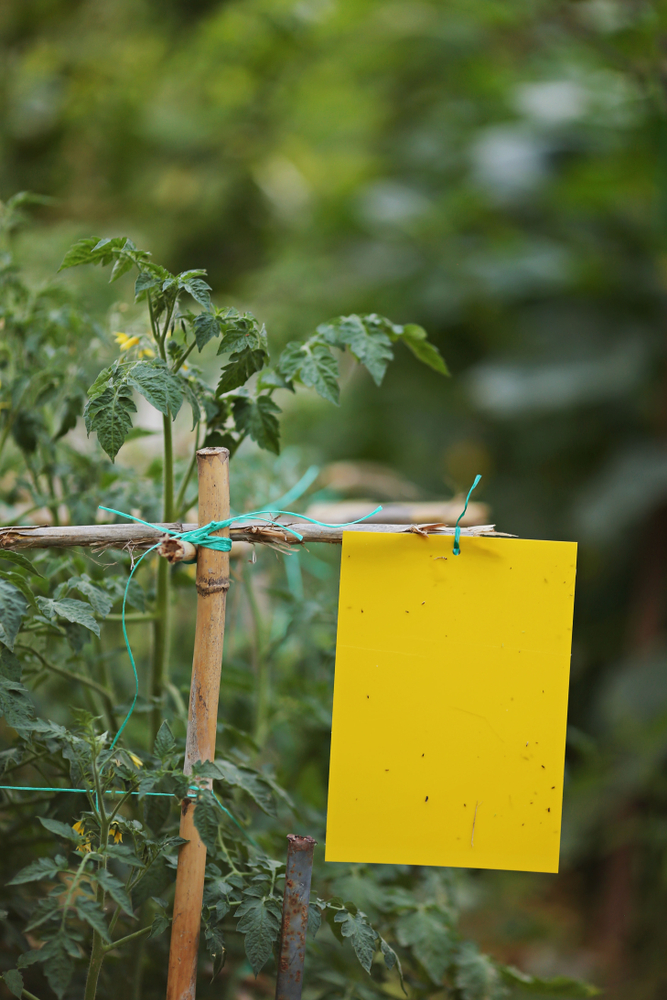
You may see slight yellow or purple discoloration of the mid-rib and edges of upper leaves. Leaves may curl.
Always remove any infected material as soon as possible. Be vigilant to reduce the chances of the infestation getting out of control.
To reduce the chances of infestation, avoid planting mallows and other perennial host plants near your tomatoes. Encourage spiders, birds and other natural predators.
11. Slugs and Snails
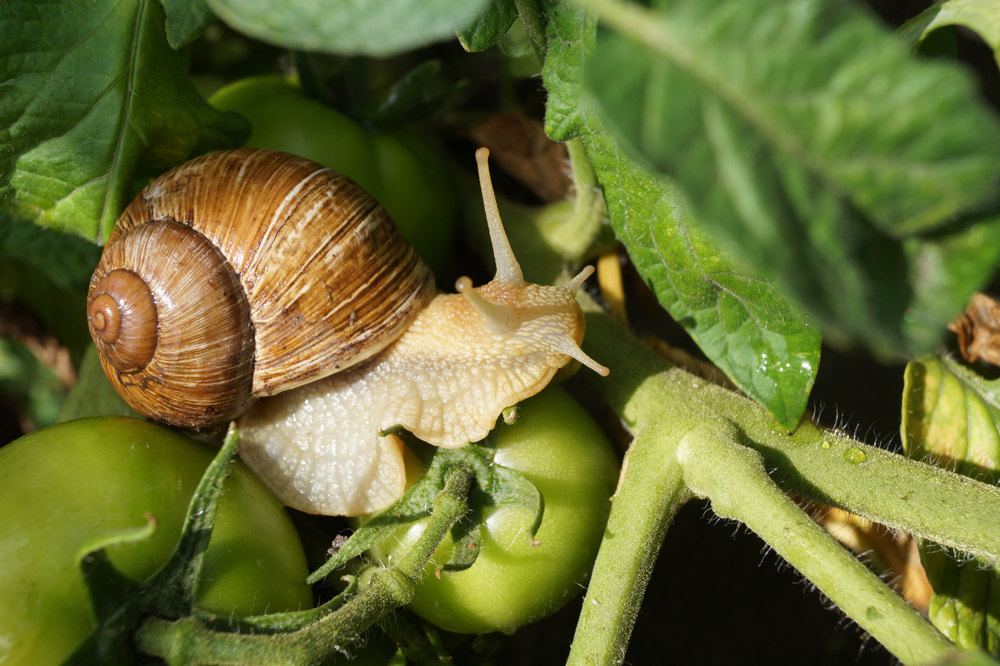
Slugs and snails will be part of a healthy ecosystem in many gardens and having some will usually be a fact of life.
That said, you will have to control populations if they are too large. Slugs and snails can cause a lot of damage and are a particular problem for younger tomato plants.
The most effective way to control slug and snail populations in your garden is to make sure that you have predators around to keep their numbers down.
Attract birds, amphibians, reptiles, some small mammals etc.. Keeping chickens or ducks can also help you control populations.
If you have a bad population imbalance then you will probably have to trap and kill some slugs and snails. (Though this is a short term, partial solution.)
One popular trap is a bottle half buried in the soil with two holes cut in the side, half filled with beer. (Put a stick leading out of the bottle to allow other creatures to escape.) Slugs/snails will enter, get drunk and drown.
You can also pick these off your plants and out of your garden by hand.
Any moist damp places will be hiding places for slugs and snails. Look in these spots and you will see congregations and be able to establish the scale of the problem.
Slugs and snails are found in greater numbers after dark. Go to the garden with a flashlight and remove them by hand to keep numbers down.
Removal is not a long term solution, however.
Getting rid of them can create a vacuum that can cause a population boom and make the problem worse in the long term. In the short term, you can also try to create physical barriers to keep slugs off your tomato plants.
12. Spider Mites
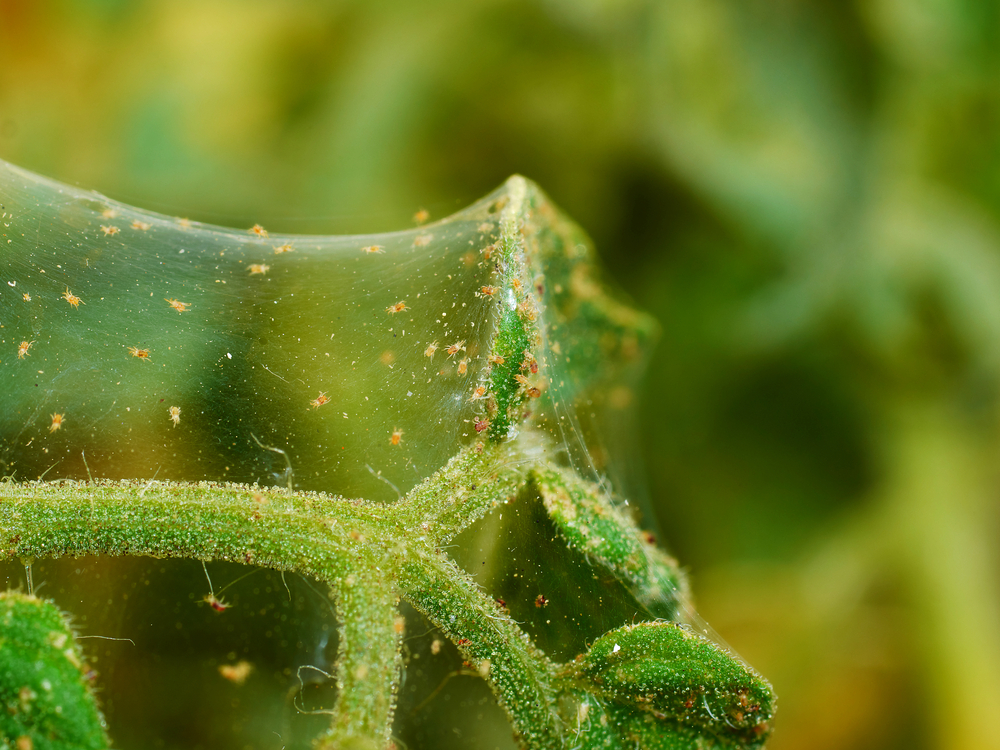
These tiny arachnids can infest and damage a range of crops, including tomatoes.
Spider mites are most common in cooler temperate climates when plants are in a greenhouse or indoors, but are widespread outdoors in dryer, hotter zones.
Mites live in colonies, usually on the underside of leaves.
They feed by piercing leaf tissue and drinking the fluids from the plant. At first, you may only see light dots.
As feeding continues, and in severe infestations, the leaves can turn yellow and drop off. Keep a look out for tight webs that are formed under leaves and along stems.
Remove and dispose of any infested material quickly, far away from composting and growing areas. Reduce the risk of infestation by keeping plants well-watered and free from stress.
Biological controls are also available to deal with certain spider mites.
13. Stalk Borer
The stalk borer is a caterpillar that can attack tomato plants in parts of the US.
It bores into the stems of tomato plants (and other plant hosts) and can often cause them to wilt and die. The entrance hole is small and often difficult to find.
The adult is an inconspicuous gray-brown moth.
The caterpillar is easier to identify. It is purple and cream striped, with a solid purple band around its body around 1/3 of the way back from its head.
Cut down and remove any plants that have died. This may also kill the caterpillar that has infested the plants.
Good weed control, especially the removal of tall, weedy grasses can also help to control the pest.
14. Stinkbugs
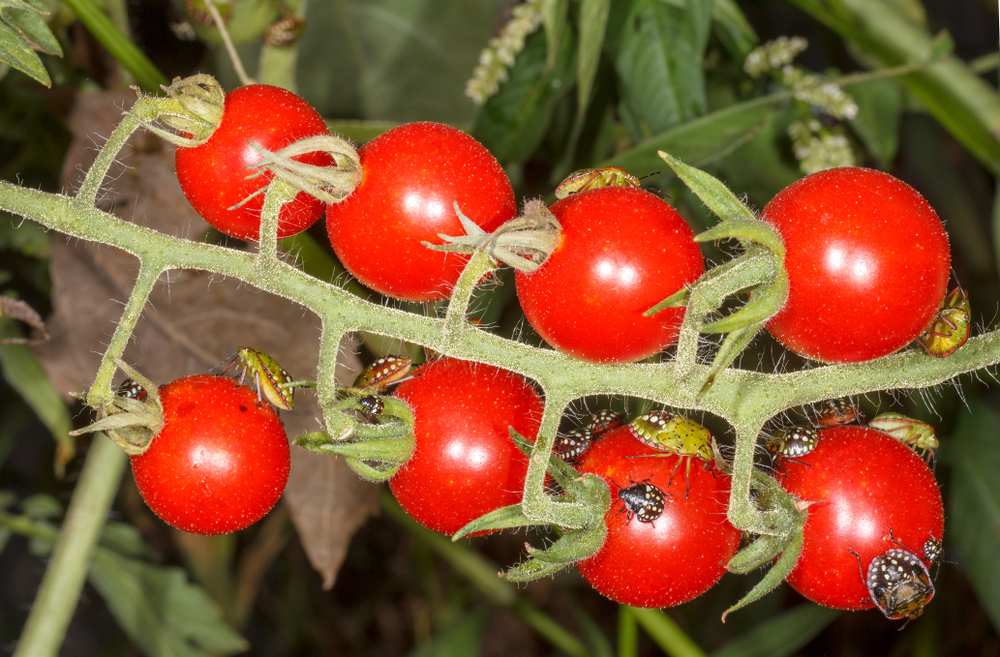
Stinkbugs do minimal damage to tomato leaves and stems. But they can carry viruses that can infect your plants.
They can also feed on immature fruits and cause them to drop, or cause scars or damage to mature tomato fruits.
Hand pick these bugs off your plants.
Be sure to look closely underneath leaves and among the fruits.
Encourage the stink bugs natural predators, such as birds, spiders and other insects, to keep numbers of these pests within controllable levels.
You can also plant millet, buckwheat, sorghum, sunflowers, marigolds, garlic, lavender, and chrysanthemums.
These are all said to be good trap crops for these pests.
You can also create a barrier to these bugs on your tomato plants by spraying them with a water and kaolin clay solution.
15. Tarnished Plant Bugs
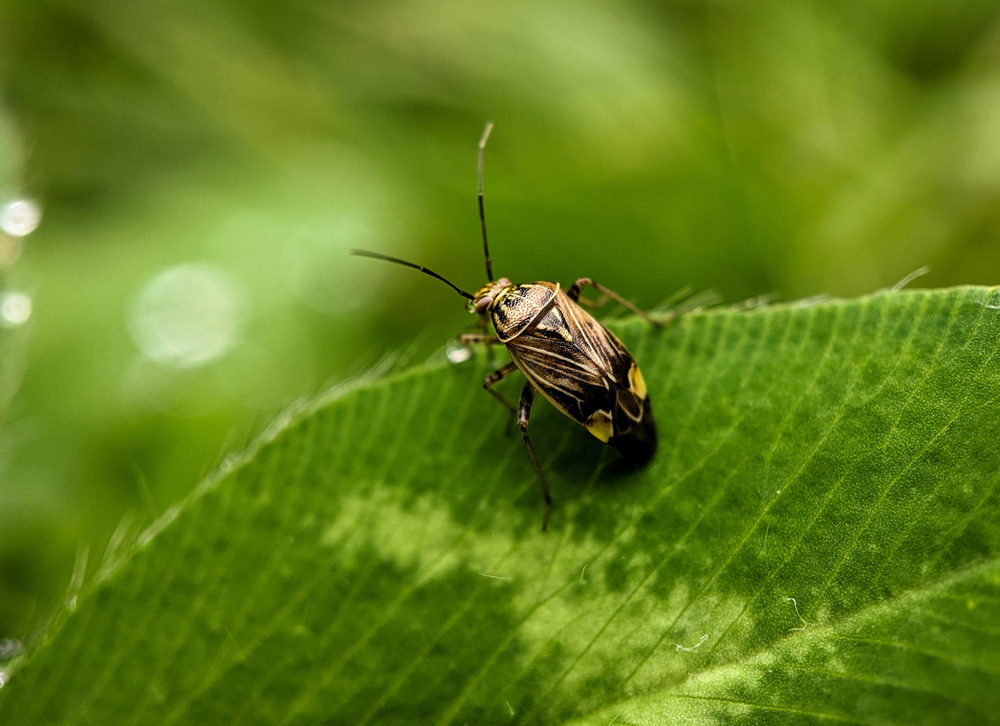
The tarnished plant bug, Lygus lineolaris, is a species of plant-feeding insect that can be a pest of tomato plants. It is found across North America but is more common on the eastern side of the US.
These bugs suck juices from shoots, leaves, flower buds, and fruits. They can leave black spots, and carry and spread disease.
They can also cause catfacing on tomato fruits and can leave cloudy spots on fruit. You can spray with a kaolin clay solution to deter them from laying eggs and feeding on your plants.
Encourage predators to keep their population in check. Tarnished plant bug predators include big-eyed bugs, damsel bugs, and pirate bugs.
Remove any weeds that tarnished plant bugs feed on from your tomato growing beds.
Dandelion, chickweed, lamb’s quarters, smartweed, wild mustard, curly doc, and pigweed are all examples of potential hosts that could make an infestation more likely.
16. Thrips

Thrips are tiny insects that are fairly difficult to see, so infestations can easily get out of control before you notice them.
Telltale signs of a thrips attack include dry or brown spotted leaves, fallen leaves, and blotchy blossoms.
Thrips can be carriers for spotted wilt virus, so while they themselves are unlikely to kill your plants, they could carry diseases that might.
Look out for infestations and remove infested material as quickly as possible.
Attract beneficial, predatory insects like ladybugs through planting, and encourage insect eating birds to your garden to keep thrips populations in check.
For severe infestations, consider organic soap based sprays.
17. Tomato Fruitworms
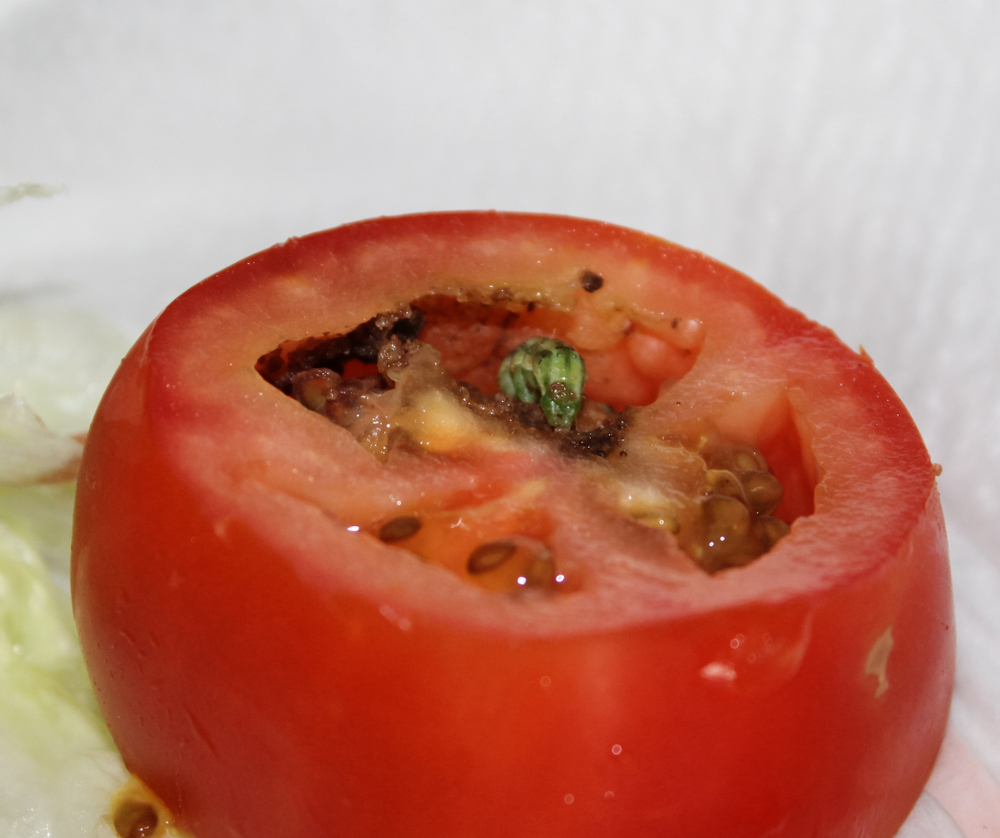
Tomato fruitworms are the larvae of moths that lay their eggs on tomato plants. Tiny worms make their way into the tomatoes, and destroy the fruits from the inside.
You may not always notice this problem right away, as the fruits often look fine from the outside.
Remain vigilant and pick and destroy fruitworm eggs and larvae as you find them. The fruitworm eggs are white when first laid, then turn brown before the larvae hatch.
Dealing with eggs is easier than dealing with larvae once they emerge.
But if larvae are on your plants, you may decide to introduce or encourage predators to tackle the problem.
Predators for tomato fruitworms include minute pirate bugs, bigeyed bugs, the parasite trichogramma and Hyposoter exiguae wasps.
18. Tortoise Beetles
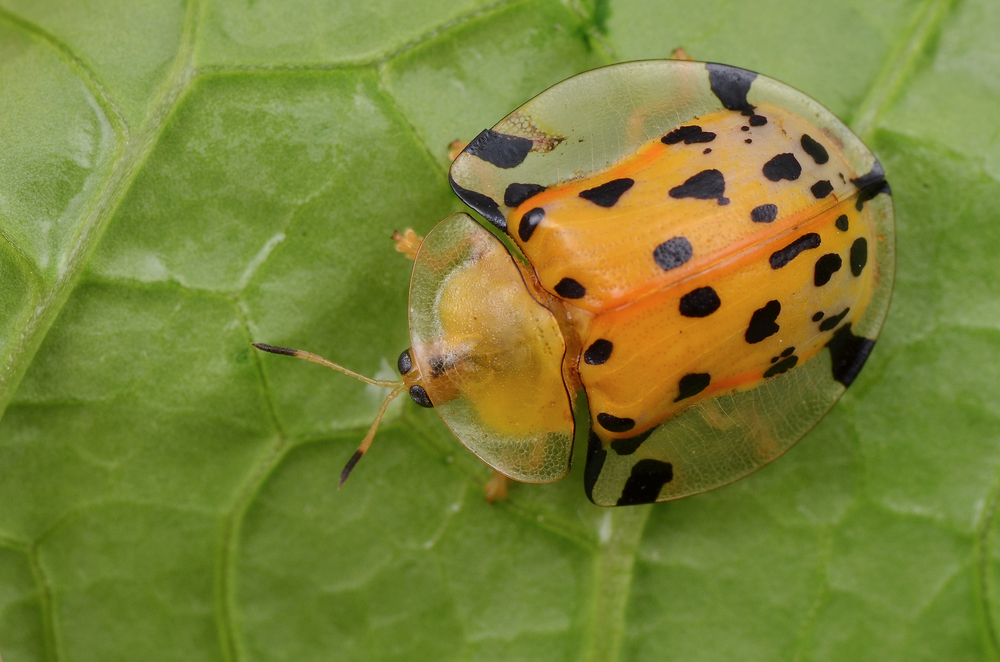
Several species of tortoise beetles feed on the undersides of tomato plant foliage in North America. They can leave leaves speckled with small, round holes.
While the damage is usually slight, large populations can cause pretty bad damage, and may even cause seedlings to fail to thrive.
Pick off the beetles by hand where they are causing a problem. However, since the damage is usually only cosmetic, control is not usually required.
Bear in mind that tortoise beetles can actually be beneficial insects because they feed on nasty, hard-to-eliminate weeds, such as horsenettle (Solanum carolinense), musk thistle (Carduus nutans) and field bindweed.
So pick the beetles off your tomato plants and place them on unwanted weeds instead.
19. Whiteflies
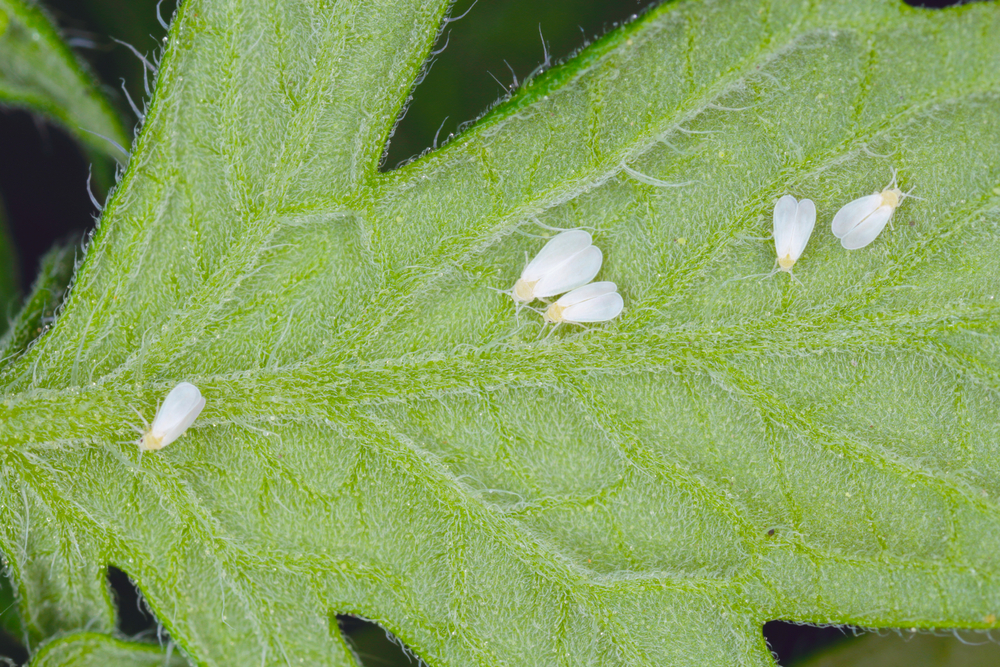
Whiteflies are tiny insects closely related to aphids.
They can be found in almost any region and commonly feed on the underside of plant leaves.
Whiteflies are commonly found on tomatoes, especially when they are grown indoors or in greenhouses.
Nymphs and adults both damage plants by sucking juices, causing stunted growth, leaf yellowing and reduced yields.
Whiteflies can spread diseases and make plants more susceptible to other problems. So it is important to nip infestations in the bud before they become too bad.
Attract predatory insects to keep their numbers down. And consider other measures as described for aphids (above).
20. Wireworms
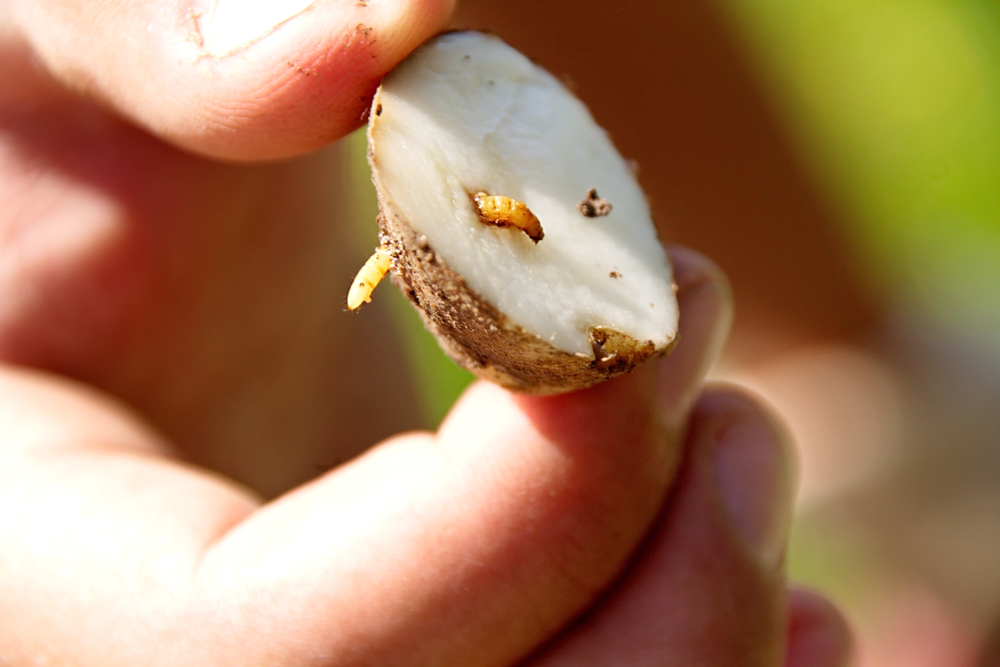
Wireworms are the larval stage of click beetles.
They are a common pest in the UK, across the United States and elsewhere. Wireworms attack germinating seeds and roots and can affect tomatoes, as they can a wide range of other garden crops.
They usually attack young tomato plant roots, and burrow up the stem to eat that as well.
You may even see them on top of the soil surface eating out of the main stem near the base.
Wireworms can be common where a new vegetable patch has been created on a previously undisturbed area covered with lawn. Exposing the soil to natural predators such as birds before planting can help reduce incidence of any problems.
You can also use a potato as a wireworm trap. Cut the potato in half and run a stick through the middle. Bury it with the stick protruding from the soil, around an inch underground.
After a couple of days, pull out the trap and dispose of any wireworms it has attracted.
Make sure you have good crop rotation practices, and do whatever you can to attract birds that eat wireworms to your garden.
Reading a list of common pests can make gardening seem rather a daunting task.
But generally speaking, tomato growing is relatively hassle free. Pests are usually easily managed as long as you strive to keep the balance in your garden ecosystem, and keep plants as healthy as possible.

Get the famous Rural Sprout newsletter delivered to your inbox.
Join the 50,000+ gardeners who get timely gardening tutorials, tips and tasks delivered direct to their inbox.


